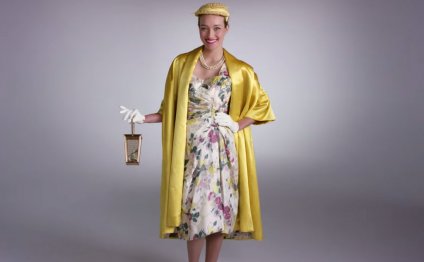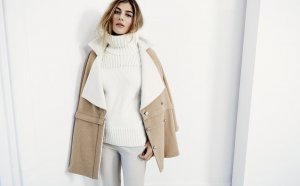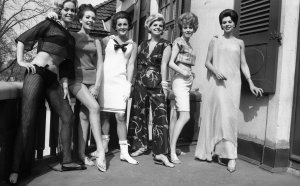
Fashion trends Through the Years
 It is amazing to observe how the different activities of all time have influenced and altered just how folks have clothed throughout time. Several of the most well-known fashions tend to be classic, they can stand the test of the time and hardly ever "go out of style", only experiencing small modifications to keep up utilizing the trends. Other clothes items might be considered "fads", types which can be only popular for a short period then never ever worn again. Often particular manner styles are dependent on the preferences of specific groups of people or cliques consequently they are frequently related to personal condition or social tastes like variety of songs an individual likes. Style can be influenced by globe occasions particularly war or even the economic climate. As an example, during World War II, individuals were just permitted a lot of textile so they were obligated to develop easy outfits that were practical enough for wartime obligations. From 1920s to the 1990s, preferred fashions reflected the feeling of each ten years and presented changes in culture as types of garments and accessories developed using times.
It is amazing to observe how the different activities of all time have influenced and altered just how folks have clothed throughout time. Several of the most well-known fashions tend to be classic, they can stand the test of the time and hardly ever "go out of style", only experiencing small modifications to keep up utilizing the trends. Other clothes items might be considered "fads", types which can be only popular for a short period then never ever worn again. Often particular manner styles are dependent on the preferences of specific groups of people or cliques consequently they are frequently related to personal condition or social tastes like variety of songs an individual likes. Style can be influenced by globe occasions particularly war or even the economic climate. As an example, during World War II, individuals were just permitted a lot of textile so they were obligated to develop easy outfits that were practical enough for wartime obligations. From 1920s to the 1990s, preferred fashions reflected the feeling of each ten years and presented changes in culture as types of garments and accessories developed using times.
Outfits and Skirts - From Mini to Maxi, Pleats to Pencil
Alterations in dresses and dress style have altered and diverse significantly involving the 1920s for this, as well as within each decade. In 1920, just a few many years after World War I, dress and dress hemlines rose and waistline lines lowered on hip. These modifications followed the boyish flapper fashions that noted the 1920s as ten years of decadence and fun. During 1926 to 1928, hemlines had been reported to be at their highest but once the currency markets crashed in 1929 and also the Great Depression emerge, hem lines returned to an even more conventional size (underneath the knee or lower). 1930s boasted a return to femininity and Hollywood allure had been idolized. Evening gowns showed bias-cuts and diamante accents and had been made of chiffon or velvet. For a more informal try the thirties outfits had been slim-cut along with wide arms and a belt all over waistline. Real fur accents and flowery prints had been also popular in this age until World War II smashed down plus the glamorous appearance of the decade destroyed its luster.During World War II, luxurious materials like wool, silk and nylon had been highly regulated and ladies' dresses and outfits had been often made from viscose and rayon. Dresses and dresses would be made out of something that might be found within a home (like curtains, nightgowns or bedsheets) due to the illegality of utilizing extra textile when making an outfit from about 1942 to 1947. Using the economic growth inside 1950s, allure be trendy once again and A-line and pencil skirts were preferred form-fitting fashions. Clothes when you look at the ten years would frequently feature stylish ruffles or lace accents and were generally knee-length or tea-length. Entering the late fifties and 1960s mini-dresses and maxi-length skirt clothes joined the scene. Mod fashioned outfits with short skirts and strong, colorful patterns became popular. Mary Quant, a Mod clothier is among the folks credited with producing the iconic mini-skirt regarding the mid-sixties. Within the late sixties and seventies hippie fashion took over and loose-fitting, streaming maxi skirts and dresses became dominant. Disco songs and dance also affected clothes with slim outlines, moving dresses together with shimmering fabrics that would look finest in every night club.
Mod fashioned outfits with short skirts and strong, colorful patterns became popular. Mary Quant, a Mod clothier is among the folks credited with producing the iconic mini-skirt regarding the mid-sixties. Within the late sixties and seventies hippie fashion took over and loose-fitting, streaming maxi skirts and dresses became dominant. Disco songs and dance also affected clothes with slim outlines, moving dresses together with shimmering fabrics that would look finest in every night club.
Once we joined the 1980s, manner developed once more. Skirts and clothes had been yet again much longer and showcased right outlines and much more severe design. As increasing numbers of women joined up with the expert employees business suits became a trend for ladies with right conservative dresses and broad-shouldered, boxy blazers topped the appearance. Into the eighties, style became extremely impacted by music stars and films with eclectic appearances shown off by Madonna, Cyndi Lauper, and celeb Molly Ringwald. Into the 1990s, dresses and dresses weren't as prominent and much more everyday looks became acceptable with hip-hop and alternate music setting the scene for fashion early in the ten years. Skirts and clothes were typically short and even provocative, especially in the latter area of the ten years, but free and streaming dresses along with long denim skirts were also notable styles.
Tops, Shirts and Tops
In 1920s, the jumper blouse was introduced and became extremely popular. Usually the jumper blouse was made from cotton fiber or silk together with a sailor collar. Ideal for combining with a skirt, it often reached just underneath the sides and would-be combined with a belt or sash. Another popular sort of twenties blouse ended up being a low-cut v-neck clothing with a chemisette mounted on market modesty. Knitted long-sleeve t-shirts with curved collars and container tops had been also popular when you look at the decade. For males, polo t-shirts, dress tops and sweaters were the tops of preference. Going into the thirties, feminine tops that featured v-necks and long bow ties connected all over neck, sleeveless blouses and knit tops of satin and linen had been preferred. During the war-torn forties nylon and silk were replaced with rayon and viscose for formal tops, while terry cloth, linen and even canvas were used for leisure shirts. Ladies who worked during World War II wore military style t-shirts which had button-up collars, and women who were part of the American female's Auxiliary Corps would wear a complete war military outfit.
During the war-torn forties nylon and silk were replaced with rayon and viscose for formal tops, while terry cloth, linen and even canvas were used for leisure shirts. Ladies who worked during World War II wore military style t-shirts which had button-up collars, and women who were part of the American female's Auxiliary Corps would wear a complete war military outfit.
After World War II finished, until the mid-1950s trends in women's style changed again. Round-neck designs on sleeveless shirts or long sleeve tops had been preferred, in addition to polo-necks. Dolman sleeves ruled stylish tops when you look at the fifties and sixties, also. The 1960s introduced cultural printing blouses, ribbed turtleneck sweaters and boat-neck tops into main-stream clothes. And, tops for men and ladies frequently showcased "wild" patterns. From the belated sixties to your mid-seventies, extremely colorful shirts and blouses with psychedelic patterns had been trendy and hippie fashion made Indian cheesecloth shirts, peasant tops, tunics and Nehru jackets well-known both for gents and ladies of the age. Space-like and futuristic fashions additionally shot to popularity and several tops were made out of suede, fabric, vinyl and synthetic.
In 1980s, as designs became somewhat even more everyday and T-Shirts and polo tops became appropriate tops, as well as for formal or business-wear, boxy tops with shoulder pads, blazers, gown tops and sweaters were preferred for males and women in the ten years. Over-sized tops had been well-known in the 80s and 90s aswell. The 1990's saw much more commercialization of manner with designer labels appearing on the exterior of clothing as a way to market status and trendiness. That trend goes on today because it's not unusual to see individuals wearing stylish everyday t-shirts that host a striking Guess or Ralph Lauren logo design regarding the front. The 1990s additionally saw a rise in the popularity of crop tops and halter tops as women's types became more provocative. In the late 80s, 90s, and in these days's fashion, T-shirts have grown to be more of a method to show individuality and an individual's tastes and choice with sassy catch phrases, funny photographs, or pop music culture recommendations showing up more and more when you look at the mainstream.
Footwear
Inside 1920s, women's footwear would often feature large and large heels whether on a pump or loafer design footwear. Many women even would wear heeled shoes with their cycling costumes as a mark of femininity. Oxfords of differing styles and colors had been popular also with gents and ladies, and lace up shoes. During the 1930s strapped pumps and pumps surged in appeal, while more traditional varieties of pumps remained used. For males and females, laced leather-based leisure footwear were well-known for outside activities and exercise during ten years. Within the forties, because of the war, footwear became much more conventional and useful. Women's footwear were typically made with flatter pumps together with either cork or wood bottoms.



RELATED VIDEO



Share this Post
Related posts
Winter Style
WinterStyle.com specializes in premium quality winter months outerwear accessories. Discover the seasons hottest winter months…
Read MoreFashion trends from the past
Ashion has a tendency to repeat itself … plenty. Actually occasionally it is appears that s all it does is ‘borrow’ from…
Read More










